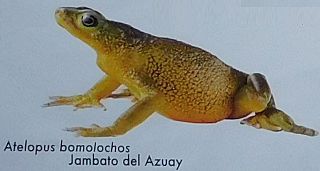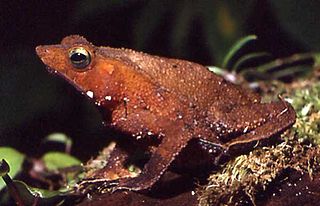
Hemiphractus is a genus of frogs, the horned treefrogs, in the family Hemiphractidae. These overall brownish frogs have a pointed snout and a casque on the head. They are nocturnal, relatively rare and native to humid lowland and highland forests in northern South America and Panama, where typically found on the ground or at relatively low levels in vegetation.

Atelopus bomolochos, the Azuay stubfoot toad or Cuenca jambato frog, is a species of toad in the family Bufonidae. It is endemic to southern Ecuador and known from Cordillera Oriental in the Azuay, Cañar, and Loja Provinces.
Atelopus planispina is a species of toad in the family Bufonidae. It is endemic to the eastern slopes of the Andes of Ecuador. According to the IUCN SSC Amphibian Specialist Group, it is restricted to the Napo Province, although other sources suggest somewhat wider range. It has not been seen since 1985 and might already be extinct. Common names Planispina's harlequin frog, Napo stubfoot toad, and flat-spined atelopus have been coined for it.

Rhinella proboscidea is a species of small South American toad in the family Bufonidae, common in the Amazon rainforest. It is the only species known to practice reproductive necrophilia.
Hyloxalus bocagei is a species of frog in the family Dendrobatidae. It is found on the northeastern side of the Andes in Ecuador and in Colombia. The specific name bocagei honors José Vicente Barbosa du Bocage, a Portuguese zoologist. Common name Bocage's rocket frog has been coined for this species.
Hyloxalus fuliginosus is a species of frog in the family Dendrobatidae. It may be endemic to Ecuador where it is known from the Amazonian slopes of the Andes in the northern Ecuador, with some sources reporting it from Colombia and Venezuela.
Hyloxalus pulchellus is a species of frog in the family Dendrobatidae from northern Ecuador and southern Colombia. Colombina source does not include Nariño but does include Putumayo Department.

The Imbabura tree frog is a species of frog in the family Hylidae found in the Pacific lowlands of western Colombia and northwestern Ecuador from the sea level to 1,000 m (3,300 ft) asl.

Scinax ruber is a species of frog in the family Hylidae which is known in English as the red snouted treefrog or red-snouted treefrog, sometimes also Allen's snouted treefrog, the latter referring to the now-synonymized Scinax alleni. This widespread species is found in much of Amazonian and northern coastal South America and into Panama, as well as in some Caribbean islands as introduced populations. It is a complex containing several cryptic species.
Strabomantis cornutus is a species of frog in the family Strabomantidae. It is found along the eastern flank of the Andes of Ecuador and Colombia north to Caquetá Department. Common name Rio Suno robber frog has been coined for it. It has been confused with other species.
Pristimantis croceoinguinis is a species of frog in the family Strabomantidae. It is found in the lowland Amazon rainforest of southern Colombia, eastern Ecuador, and extreme north-eastern Peru, likely also extending into the adjacent Brazil. The specific name croceoinguinis refers to the color of the inguinal spots of this frog. Common name Santa Cecilia robber frog has been proposed for it.
Niceforonia dolops is a species of frog in the family Strabomantidae. It is found in the Andes of southern Colombia and northern Ecuador. Specifically, it is known from the Cordillera Oriental and Colombian Massif in Caquetá and Putumayo Departments, Colombia, and Napo Province, Ecuador. Common name Putumayo robber frog has been coined for it.
Pristimantis eremitus is a species of frog in the family Strabomantidae. It is found in the Cordillera Occidental in north-western Ecuador from the Cotopaxi Province northward and on western slope of the Colombian Massif in the Nariño Department, extreme south-western Colombia. The specific name eremitus is Latin for "lonely" or "solitary" and refers to this species being the only western-Andean species among its closest relatives. Common names Chiriboga robber frog and lonely rainfrog have been coined for it.

Pristimantis katoptroides is a species of frog in the family Strabomantidae. It is found in the eastern slopes of the Andes of Ecuador and Cordillera Central and eastern Andean foothills in northwestern Peru. The specific name katoptroides is Greek for "mirror-like" and refers to the similarity of this species to Pristimantis crucifer, but being found on the other side of the Andes. Common name Puyo robber frog has been proposed for it.
Pristimantis ortizi is a species of frog in the family Strabomantidae. As currently known, it is endemic to northern Ecuador where it occurs on the Cordillera Oriental in the Carchi, Imbabura, and Napo Provinces, but it is likely to also occur in adjacent Colombia. The specific name ortizi honors Fernando Ortiz-Crespo, a prominent Ecuadorian ornithologist. Common names Ortiz robber frog and Ortiz's robber frog have been proposed for this species.

Pristimantis scolodiscus is a species of frog in the family Strabomantidae. It is found on the Pacific slopes of the Andes in northern Ecuador and in the Colombian Massif in the Nariño Department in the adjacent south-western Colombia. Its elevational range is 1,200–1,780 m (3,940–5,840 ft) above sea level.

Hemiphractus bubalus, or the Ecuador horned tree frog, is a species of frog in the family Hemiphractidae. It is found in the upper Amazon Basin and lower Amazonian slopes of the Andes in northern Peru, Ecuador, and southern Colombia . Its natural habitat is dense cloud forest. It is typically found perching on branches of bushes and small trees. It is assumed to be a predator of other frog species. It is sensitive to habitat modification and is threatened by habitat loss.

Hemiphractus fasciatus, or the banded horned treefrog, is a species of frog in the family Hemiphractidae. It is found in northwestern Ecuador and possibly the Pacific slopes of the Cordillera Occidental in Colombia; although formerly listed for Panama, this involves the similar and closely related H. elioti, H. kaylockae and H. panamensis. It is a relatively large frog that may readily bite.
Lynchius parkeri, also known as Parker's Andes frog, is a species of frog in the family Strabomantidae. It is found in northern Peru and southern Ecuador. The specific name parkeri honors Hampton Wildman Parker, English zoologist and herpetologist.

Hamptophryne boliviana, also known as the Bolivian bleating frog or Amazon sheep frog, is a species of frogs in the family Microhylidae. It is found in the northern and western sides of the Amazon basin in Bolivia, Brazil, Colombia, Ecuador, French Guiana, Guyana, Peru, Suriname, and Venezuela. Genetic analysis suggests hidden diversity within the nominal species.









